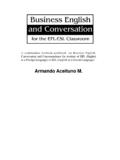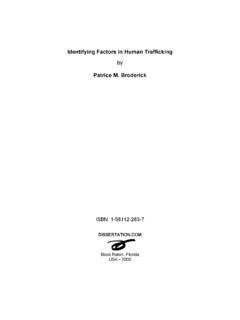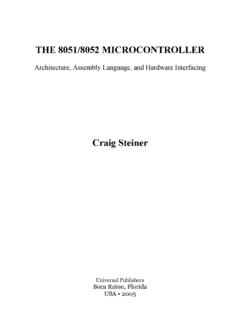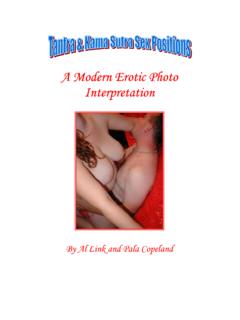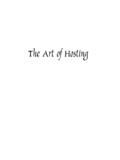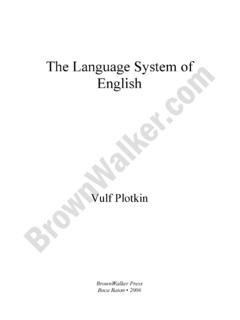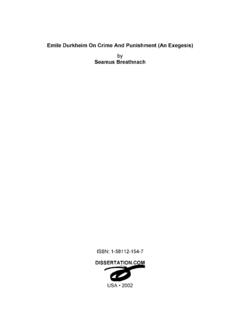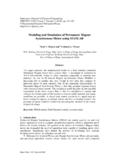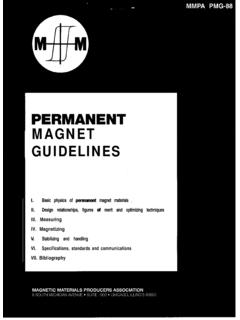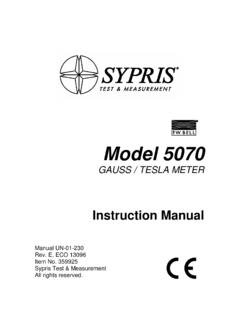Transcription of Instrumentation and Measurement in Electrical …
1 Instrumentation AND Measurement IN Electrical ENGINEERING Instrumentation AND Measurement IN Electrical ENGINEERING ROMAN MALARI BrownWalker Press Boca Raton Instrumentation and Measurement in Electrical Engineering Copyright 2011 Roman Malari All rights reserved. No part of this book may be reproduced or transmitted in any form or by any means, electronic or mechanical, including photocopying, recording, or by any information storage and retrieval system, without written permission from the publisher. BrownWalker Press Boca Raton, Florida USA 2011 ISBN-10: 1-61233-500-4 (paper) ISBN-13: 978-1-61233-500-1 (paper) ISBN-10: 1-61233-501-2 (ebook) ISBN-13: 978-1-61233-501-8 (ebook) Some of the Electrical symbols used in this book VII PREFACE The inclusion of an Electrical Measurement course in the undergraduate curriculum of Electrical engi-neering is important in forming the technical and scientific knowledge of future Electrical engineers.
2 This book explains the basic Measurement techniques, instruments, and methods used in everyday practice. It covers in detail both analogue and digital instruments, measurements errors and uncertain-ty, instrument transformers, bridges, amplifiers, oscilloscopes, data acquisition, sensors, instrument controls and Measurement systems. The reader will learn how to apply the most appropriate meas-urement method and instrument for a particular application, and how to assemble the Measurement system from physical quantity to the digital data in a computer. The book is primarily intended to cover all necessary topics of Instrumentation and Measurement for students of Electrical engineering, but can also serve as a reference for engineers and practitioners to expand or refresh their knowledge in this field. IX ACKNOWLEDGMENTS I would like to thank Ivica Kun t, dipl. ing for his suggestions and for designing most of the figures in this book.
3 I also wish to thank my colleagues at the Faculty, as well as my colleagues from the TEMUS-158599 project Creation of the Third Cycle of Studies Doctoral Studies in Metrology for their support. Special thanks go to my mother Marija, father Vladimir, and my brother Kre imir for their encouragement and assistance. And finally, thanks to my wife Bo ica and to my kids for their patience and support. XI INTRODUCTION Measurement followed man from the very beginning of its development. measuring methods and measuring instruments were developed in parallel with the development of Electrical engineering. However, some physical laws were derived based on Measurement results, such as the Biot-Savart law, when in 1820, the French scientists Jean-Baptiste Biot and F lix Savart established the relation-ship between an electric current and the magnetic field it produces.
4 Although science and metrology (the science of measurements) are developing quickly, one should always remember that a measure-ment principle established more than 150 years ago can still be applicable today. There will be many such principles explained in this book. As the Instrumentation becomes more advanced, results will only become more precise. The basic purpose of metrology is best described by the famous Italian scientist Galileo Galilei: Measure everything that can be measured and try to make measurable what is not yet measurable. The term metrology is derived from the Greek words metron to measure and logos science. The process of Measurement involves comparison of the measured quantity with the specific unit; it is therefore necessary to know the unit of Measurement with the highest possible accuracy. The first modern me-trology institute was established in 1887 in Germany.
5 This institute was partly responsible for the sudden rise of strength of German industry in the world. Very soon thereafter, other industrial coun-tries established metrology institutes in order to maintain their places at the top of world industry. With the progress of science foundation around the world, metrology slowly relied more and more on natural phenomena and not on prototypes, as in the past. Today, the only unit of Measurement em-bodied in prototype kilogram is stored in S vres near Paris, but in recent years, the metrology world appears to desire to define this unit by natural phenomena just like all the others. Today, metrology is based on natural laws and is unique in how the units can be realized anywhere in the world, if only one has the necessary knowledge and equipment. The foundation of today s me-trology is the International System of Units (SI), adopted in 1960. This system consists of seven base units and a large number of derived units, 23 of which have their own special names and signs.
6 Only Electrical current is included in the seven base units from Electrical engineering. All others, such as units for Electrical resistance and voltage, are derived units. Chapter 1 gives an overview of the modern SI system of units, and explains the definition of SI base units, its realization, and its standards. Chapter 2 describes Measurement errors, calculation of Measurement uncertainty, and instrumenta-tion limits of errors. Chapter 3 describes the different measuring elements such as resistors, inductors, and capacitors, as well as voltage standards. Chapter 4 describes the analogue measuring instruments, and how to use different types to measure various AC and DC voltages and currents. Chapter 5 is about the compensation Measurement methods, such as bridges and compensators. AC and DC calibrators are also described. Instrumentation AND Measurement IN Electrical ENGINEERING XII Chapter 6 gives an overview of instrument transformers, their uses, and testing methods for determi-nation of phase and current/voltage errors.
7 Chapter 7 describes the use of operation amplifiers in Measurement technology, and how to use them to build electronic instruments and other devices using the op-amps. Chapter 8 gives an overview of cathode ray tube and digital storage oscilloscopes. How to use oscillo-scopes to measure different Electrical quantities is also described. Chapter 9 describes the construction and use of digital multimeters, and provides an overview of dif-ferent analogue to digital converters used in various digital instruments. Chapter 10 describes Measurement methods to measure different Electrical quantities, such as voltage, current, resistance capacitance, and many others. Chapter 11 describes the historical development of instrument control with the use of the personal computer, as well as different connectivity interface buses and software support for both stand-alone and modular Instrumentation . Chapter 12 gives an overview of the Measurement system, and describes the most popular sensors, signal conditioning, and data acquisition hardware.
8 XIII TABLE OF CONTENTS Preface .. VII Acknowledgments .. IX XI Acronyms and Abbreviations .. XIX 1. INTERNATIONAL SYSTEM OF UNITS - SI .. 1 DEFINITIONS OF THE SI BASE UNITS .. 2 REALIZATION OF UNITS .. 5 PHYSICAL STANDARDS OF UNITS .. 6 TRACEABILITY .. 6 UNITS OUTSIDE THE SI .. 7 SI PREFIXES .. 8 BINARY UNITS .. 8 2. Measurement ERRORS .. 11 GRAVE ERRORS .. 12 SYSTEMATIC ERRORS .. 12 RANDOM ERRORS .. 12 CONFIDENCE LIMITS .. 16 Measurement UNCERTAINTY .. 18 LIMITS OF ERROR (SPECIFICATIONS) .. 19 Indirectly Measured 20 3. measuring ELEMENTS .. 23 RESISTORS .. 23 Resistance Decades and Slide Resistors .. 24 Resistance Standards .. 25 Oil Bath .. 27 Group Standards .. 29 Hamon Transfer Resistor .. 33 Quantum Hall Resistance Standard .. 34 CAPACITORS .. 35 Equivalent Circuit of Capacitors .. 35 Capacitor Standards .. 36 INDUCTORS .. 37 Equivalent Circuit of Inductors .. 38 Inductance Standards.
9 38 LABORATORY VOLTAGE SOURCES .. 39 VOLTAGE STANDARDS .. 39 Josephson Array Voltage Standard .. 39 Weston Voltage Standard .. 40 Electronic Voltage Standards .. 42 ADJUSTING THE CURRENT .. 43 Adjusting the Current with Potentiometer .. 43 Adjusting the Current with Resistor .. 44 Instrumentation AND Measurement IN Electrical ENGINEERING XIV 4. ANALOGUE measuring INSTRUMENTS .. 47 BASIC CHARACTERISTICS OF ANALOGUE INSTRUMENTS .. 47 Torque and Counter-Torque .. 47 The Scale and Pointing Device .. 48 Uncertainty in Reading Analogue Instruments .. 49 Sensitivity and Analogue Instrument Constant .. 50 Standards and Regulations for the Use of Analogue Electrical measuring Instruments .. 50 INSTRUMENT WITH MOVING COIL AND PERMANENT MAGNET (IMCPM) .. 52 Extending the Measurement Range .. 53 Measurement of Alternating Current and Voltage Using IMCPM .. 54 Universal measuring Instruments .. 57 INSTRUMENT WITH MOVING IRON.
10 57 ELECTRODYNAMIC INSTRUMENT .. 58 ELECTRICITY METERING .. 59 Induction Meter .. 59 Electricity Meter Testing .. 62 5. BRIDGES AND CALIBRATORS .. 65 DC BRIDGES .. 65 Wheatstone Bridge .. 65 Sensitivity of Wheatstone bridge .. 67 Partially Balanced Wheatstone Bridge .. 68 Thompson Bridge .. 68 AC WHEATSTONE BRIDGE .. 69 DC COMPENSATION METHODS .. 70 CALIBRATORS .. 72 DC Calibrator .. 72 AC Calibrator .. 74 6. INSTRUMENT TRANSFORMERS .. 77 CONNECTING INSTRUMENT TRANSFORMERS .. 77 IDEAL AND REAL TRANSFORMERS .. 77 VOLTAGE INSTRUMENT TRANSFORMER .. 79 CAPACITIVE measuring TRANSFORMERS .. 81 CURRENT INSTRUMENT TRANSFORMER .. 82 CURRENT INSTRUMENT TRANSFORMER ACCURACY TESTING .. 85 Schering and Alberti Method .. 85 Hohle Method .. 86 WINDING CONFIGURATIONS .. 87 7. AMPLIFIERS IN Measurement TECHNOLOGY .. 89 measuring AMPLIFIERS .. 89 OPERATIONAL AMPLIFIERS .. 92 OPERATIONAL AMPLIFIER APPLICATIONS.
